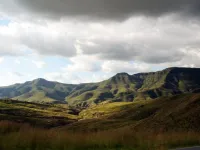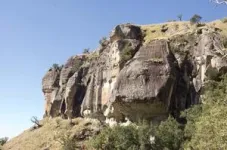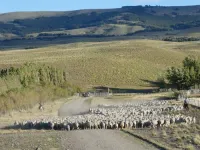(Press-News.org) Scientists at the University of Southampton have answered one of the most puzzling questions in plate tectonics: how and why ‘stable’ parts of continents gradually rise to form some of the planet’s greatest topographic features.
They have found that when tectonic plates break apart, powerful waves are triggered deep within the Earth that can cause continental surfaces to rise by over a kilometre.
Their findings help resolve a long-standing mystery about the dynamic forces that shape and connect some of the Earth’s most dramatic landforms – expansive topographic features called ‘escarpments’ and ‘plateaus’ that profoundly influence climate and biology.
The new research, led by the University of Southampton, examined the effects of global tectonic forces on landscape evolution over hundreds of millions of years. The findings are published today (07/08/2024) in the journal Nature.
Tom Gernon, Professor of Earth Science at the University of Southampton and lead author of the study said: “Scientists have long suspected that steep kilometre-high topographic features called Great Escarpments — like the classic example encircling South Africa — are formed when continents rift and eventually split apart. However, explaining why the inner parts of continents, far from such escarpments, rise and become eroded has proven much more challenging. Is this process even linked to the formation of these towering escarpments? Put simply, we didn’t know.”
The vertical motions of the stable parts of continents, called cratons, remain one of the least understood aspects of plate tectonics.
The team from the University of Southampton, including Dr Thea Hincks, Dr Derek Keir, and Alice Cunningham, collaborated with colleagues from the Helmholtz Centre Potsdam – GFZ German Research Centre for Geosciences and the University of Birmingham to address this fundamental question.
Their results help explain why parts of the continents previously thought of as ‘stable’ experience substantial uplift and erosion, and how such processes can migrate hundreds or even thousands of kilometres inland, forming sweeping elevated regions known as plateaus, like the Central Plateau of South Africa.
Linking diamonds with landscape evolution
Building on their study linking diamond eruptions to continental breakup, published last year in Nature, the team used advanced computer models and statistical methods to interrogate how the Earth’s surface has responded to the breakup of continental plates through time.
They discovered that when continents split apart, the stretching of the continental crust causes stirring movements in Earth’s mantle (the voluminous layer between the crust and the core).
Professor Sascha Brune, who leads the Geodynamic Modelling Section at GFZ Potsdam, said: “This process can be compared to a sweeping motion that moves towards the continents and disturbs their deep foundations.”
Professor Brune and Dr Anne Glerum, also based at Potsdam, ran simulations to investigate how this process unfolds. The team noticed an interesting pattern: the speed of the mantle ‘waves’ moving under the continents in their simulations closely match the speed of major erosion events that swept across the landscape in Southern Africa following the breakup of the ancient supercontinent Gondwana.
The scientists pieced together evidence to propose that the Great Escarpments originate at the edges of ancient rift valleys, much like the steep walls seen at the margins of the East African Rift today. Meanwhile, the rifting event also sets about a ‘deep mantle wave’ that travels along the continent’s base at about 15-20 kilometres per million years.
They believe that this wave convectively removes layers of rock from the continental roots.
“Much like how a hot-air balloon sheds weight to rise higher, this loss of continental material causes the continents to rise – a process called isostasy,” said Professor Brune.
Building on this, the team modelled how landscapes respond to this mantle-driven uplift. They found that migrating mantle instabilities give rise to a wave of surface erosion that lasts tens of millions of years and moves across the continent at a similar speed. This intense erosion removes a huge weight of rock that causes the land surface to rise further, forming elevated plateaus.
“Our landscape evolution models show how a sequence of events linked to rifting can result in an escarpment as well as a stable, flat plateau, even though a layer of several thousands of meters of rocks has been eroded away”, explained Jean Braun, Professor of Earth Surface Process Modelling at GFZ Potsdam, also based at the University of Potsdam.
The team’s study provides a new explanation for the puzzling vertical movements of cratons far from the edges of continents, where uplift is more common.
Dr Steve Jones, Associate Professor in Earth Systems at the University of Birmingham, added: “What we have here is a compelling argument that rifting can, in certain circumstances, directly generate long-lived continental scale upper mantle convection cells, and these rift-initiated convective systems have a profound effect on Earth’s surface topography, erosion, sedimentation and the distribution of natural resources.”
The team has concluded that the same chain of mantle disturbances that trigger diamonds to quickly rise from Earth’s deep interior also fundamentally shape continental landscapes, influencing a host of factors from regional climates and biodiversity to human settlement patterns.
Professor Gernon, who was awarded a major philanthropic grant from the WoodNext Foundation, administered by Greater Houston Community Foundation, to study global cooling, explained that continental breakup disturbs not only the deep layers of the Earth but also has effects that reverberate across the surface of the continents, previously thought to be stable.
“Destabilising the cores of the continents must have impacted ancient climates too,” concluded Professor Gernon.
ENDS
END
Scientists uncover hidden forces causing continents to rise
2024-08-07
ELSE PRESS RELEASES FROM THIS DATE:
Variability in constituents of e-cigarette products containing nicotine analogues
2024-08-07
About The Study: Discrepancies were observed between labeled and measured concentrations of nicotine analogues in e-cigarettes and e-cigarette liquids marketed as nicotine replacements and exempt from FDA’s regulatory purview. Such discrepancies may lead to uncertainty about user exposure. When coupled with the largely unknown acute and chronic inhalation hazards and addictive potential of nicotine analogues, assessing product risk based on exposure becomes challenging from a clinical and regulatory standpoint. With e-cigarettes increasingly considered for smoking cessation, the advent of nicotine analogue–containing products with ...
A vaping cessation text message program for adolescent e-cigarette users
2024-08-07
About The Study: A tailored, interactive text message intervention increased self-reported vaping cessation rates among adolescents recruited via social media channels.
Quote from corresponding author Amanda L. Graham, PhD:
“Health care providers, teachers, and parents have been asking how to help teens quit vaping. This study is a critical breakthrough that demonstrates the power of a behavioral intervention for vaping cessation. Text messages serve as powerful reminders of an initial commitment to quit and can deliver proven behavior change support right to a young person’s phone.
“We also did not see evidence that teens who quit ...
Neighborhood socioeconomic disadvantage across the life course and premature mortality
2024-08-07
About The Study: Low neighborhood socioeconomic status was associated with premature mortality in this study. The risk of premature mortality was greatest among individuals experiencing persistently low neighborhood socioeconomic status from young to middle adulthood. Place-based interventions that target neighborhood social determinants of health should be designed from a life course perspective that accounts for early-life socioeconomic inequality.
Corresponding Author: To contact the corresponding author, Wayne R. Lawrence, DrPH, email wayne.lawrence@nih.gov.
To access the embargoed ...
Cocaine discovery could pave way for treatment for substance abuse
2024-08-07
You have probably heard of dopamine. The substance also known as the “feel-good hormone”.
Drugs such as cocaine cause a surge of dopamine in the brain. Normally, a protein in the brain called the dopamine transporter (DAT) helps regulate dopamine levels and prevent the brain from thinking that every experience is pleasurable.
However, when affected by cocaine, the brain is unable to regulate dopamine levels. Previously, researchers did not know how cocaine affects the different transporters in the brain, but a new study from the University of Copenhagen has changed that.
“We have learned how cocaine binds to the dopamine transporter, which is ...
Link discovered between sensory neurons and breast cancer metastasis
2024-08-07
Cancer doesn’t grow in a vacuum—each tumor grows in a particular microenvironment within the body and spreads through a tangled web of vasculature and nerves. Scientists have come to understand that the most potent therapies address cancer in context—accounting for both the tumor and the support structure that forms around it.
Now, a new paper in Nature reveals that the activation of sensory nerves within breast tumors is playing a critical role in promoting not only cancer growth but also its spread, known as metastasis. The findings—that sensory neurons ...
Plants show surprising diversity in arid landscape
2024-08-07
Understanding how plants cope with climatic extremes and grazing pressure is important for reliable prediction about future biodiversity and the functioning of dryland ecosystems[1].
An international team, coordinated by KAUST’s Fernando Maestre, has assessed how 20 chemical and morphological plant functional traits jointly respond to changes in aridity and grazing pressure across global drylands. Increasing aridity and grazing pressure could be expected to reduce the level of plant diversity. However, the diversity of plant traits — including key traits linked to nutrient cycling such as specific leaf area and foliar ...
Plasma bubbles and the “engine” of fast radio bursts
2024-08-07
Rome, 7 August 2024 -- Fast Radio Bursts (FRBs) are one of the most recent open mysteries of modern astrophysics. Within a few milliseconds, these powerful events release an immense amount of energy, among the highest observable in cosmic phenomena. FRBs were discovered just over ten years ago and mostly arise from extragalactic sources. Their origin, however, is still uncertain and there are huge ongoing efforts by the astrophysics community around the world to understand the physical processes behind them.
In very few cases, the rapid flash that characterises FRBs coincides with a persistent ...
Microbes and their interactions the focus of major international meeting
2024-08-07
One of the academic world’s largest international meetings addressing topics in microbial ecology, the 19th International Symposium on Microbial Ecology (ISME), will take place in Cape Town, South Africa in August.
More than 1 500 scientists from over 50 countries worldwide will convene at the Cape Town International Convention Centre (CT-ICC) from 18 to 23 August 2024. This will be the first time that this prestigious meeting is held on the African continent.
Prof. Thulani Makhalanyane, chair of the ISME organising committee and professor of microbiology at Stellenbosch University (SU), ...
Heart and brain axis targets in CNS neurological disorders
2024-08-07
Recent advancements highlight the intricate interplay between the heart and brain, underscoring their profound influence on each other, especially concerning central nervous system (CNS) neurological disorders. In light of this, a new special issue aims to explore therapeutic targets that impact both cardiac and cerebral functions. By focusing on these targets, the issue seeks to provide an in-depth understanding of the complex relationship between these vital organs.
For more information and to contribute ...
Digital Science appoints new Chief People Officer
2024-08-07
Digital Science, a technology company serving stakeholders across the research ecosystem, is pleased to announce that highly experienced human resources leader and author Claire Fox has been appointed to the role of Chief People Officer.
Claire joins the Digital Science Executive Team at a time of growth for the company, with its continued mission to drive progress for all through research and innovation.
Based in London, UK, Claire has more than 20 years’ HR experience, initially in national, European and global HR leadership roles in the fast-moving consumer goods (FMCG) sector at Unilever. She then moved into international development, with senior leadership roles including ...






